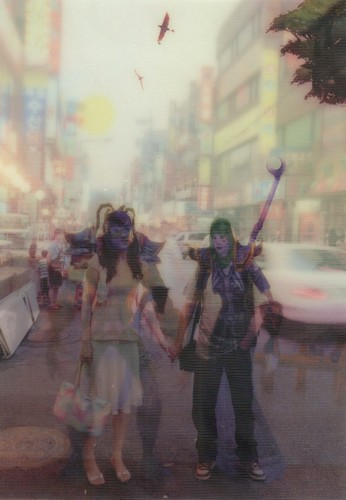Its shape is basically 6 inches wide by 12 inches high, so when you open it up it's a foot square. The top 7 inches of each page is a photograph, and the remaining 5 inches is text. On the left-hand page, you get a picture of a real-life person (or people) and some stats: name, year of birth, occupation, location, average in-game hours per week, avatar name, avatar creation year, game played, server name, character type, character level and special (character) abilities. On the right-hand page, you get a picture of the avatar and some sense of the person behind both individuals (culled from interviews byTracy Spaight). In general, the people shown have the same pose as their avatars, although sometimes there are purposefully jarring differences.
The front cover is a nice double-image so that when you look at it from one angle you get a real-life couple and from another you get their avatars. Here's the transporter accident you get when you try to scan it:

There are some fascinating people in there, plus me. I know some in real life — Philip Rosedale, Cory Ondrejka, Ailin Qin and Wagner James Au, all from Second Life — but others I've heard of elsewhere (and in the case of Harisu, separately from virtual worlds). Some of the people were also featured in Tim Guest's book (unsurprisingly, as it includes a scene in which Robbie irately complains to Tim for interviewing people he's already found and photographed). This made the following recommendation from amazon.co.uk rather amusing:

A fair number of the people featured come from the Far East, which isn't just a smart marketing move on Robbie's part: what they have to say about their virtual selves is quite enlightening. the gold farmers apart, all of them have the same kind of reasons to play as the Western players, but I did detect a stronger bias towards regarding their characters as other people, rather than as aspects of their own self. Why this might be, I'm not sure, but I suspect it's either because they've played virtual worlds for so long that they've been through the whole hero's journey thing and are at ease with their online personae, or that they have some cultural reason for regarding their real selves as separate from their virtual selves (if they were Hindus, I'd say they looked on their online selves as reincarnations rather than incarnations-in-progress, but they're not). It's fascinating stuff, at least for me...
One thing I particularly like about this book is that Robbie really knows his stuff as a photographer. There are all sorts of subtle comparisons and alignments to be made between the photographs and the avatar images, and I know they're there deliberately because I'm aware of how many pictures Robbie takes to obtain the exact one he wants (I think he did about 70 of me until he got one looking suitably stiff and expressionless, like my "avatar" — which is text). All sorts of interactions emerge. These are photographs taken by someone who really knows what he's doing.
I have two favourites at the moment: Xu Wei Qing and Francis Chang. The former is a gold farmer, who's standing on his desk with red-rimmed eyes, in a real meta-game pose (all in black, smoking); his image is a screenshot of the tools he uses to play Legend of Mir — I don't think the game itself shows at all. Francis Chang has a female avatar, Frances Chang, and they're both shot from the same angle in the same pose, with so many patterns to match (and, equally important, patterns not to match) that it's incredibly difficult not to leap into making all manner of hypotheses about the man, his life and his virtual life. It's very thought-provoking, which is why I enjoy it.
So far, I've only shown the book to my wife and children, but they all like it (even the wife and child who don't play virtual worlds). There's just something compelling about seeing a person alongside how they like to be seen, and drawing instant conclusions about what they're like.
Yes, I have to say, I'm impressed. I don't know what kind of awards are available for photojournalists, but this deserves one.